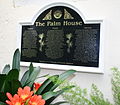Botanic Gardens, Belfast: Difference between revisions
No edit summary |
|||
| Line 65: | Line 65: | ||
[[Category:Parks in County Antrim]] | [[Category:Parks in County Antrim]] | ||
[[Category:Gardens in County Antrim]] | [[Category:Gardens in County Antrim]] | ||
[[Category:Botanical gardens in the United Kingdom]] | |||
[[Category:Belfast]] | [[Category:Belfast]] | ||
Latest revision as of 13:46, 2 March 2018

The Botanic Gardens in Belfast is a public park and botanical garden, spread over 28 acres in the midst of the city.
In their location in south Belfast, the gardens are popular with office workers, students and tourists. They are located on Stranmillis Road in 'Queen's Quarter', with The Queen's University of Belfast nearby. The Ulster Museum stands at the main entrance.[1]
There is a railway station by the gardens, named Botanic station.
History
The gardens were created in 1828 by the Belfast Botanical and Horticultural Society, as a private garden known as the Royal Belfast Botanical Gardens.
The Royal Belfast Botanical Gardens continued as a private park for many years, only opening to members of the public on Sundays before 1895. The gardens became a public park in 1895 when the Belfast Corporation bought the gardens from the Society. The Botanic Gardens still belong to Belfast City Council.[2][3]
The Palm House
The gardens' most notable feature is the Palm House conservatory. The foundation stone was laid by the Marquess of Donegall in 1839 and work was completed in 1840.[4] It is one of the earliest examples of a curvilinear cast iron glasshouses in the world. Designed by Charles Lanyon and built by Richard Turner, Belfast's Palm House predates the glasshouses at Kew and the Irish National Botanic Gardens at Glasnevin, both of which Turner went on to build.
The Palm House consists of two wings, the cool wing and the tropical wing. Lanyon altered his original plans to increase the height of the latter wing's dome, allowing for much taller plants. In the past these have included a 36 foot tall Globe Spear Lily: the lily, which is native to Australia, finally bloomed in March 2005 after a 23-year wait. The Palm House also features a 400-year-old Xanthorrhoea.
-
Plaque in 3 languages
-
Early Spring flowers
-
Urn
-
Aloe saponaria
Other features
The gardens contain another glasshouse, the Tropical Ravine House. Built by head gardener Charles McKimm in 1889, it features a unique design. A sunken ravine runs the length of the building, with a balcony at each side for viewing. The most popular attraction is the Dombeya, which flowers every February.
The Palm House and the Tropical Ravine House were symbols of Belfast's growing industrial might and prosperity in the Victorian era and attracted over 10,000 visitors a day.
The gardens also feature one of the longest herbaceous borders in the British Isles. There is a rose garden built in 1932 and various species of tree, including the hornbeam-oak. A statue of the Belfast-born physicist William Thomson, 1st Baron Kelvin stands at the Stranmillis Road entrance.
-
The Palm House
-
Botanic Green in Winter
-
Inside the Palm House
-
Botanic park sign post
-
Lord Kelvin statue at the entrance
Concerts
Concerts and music festivals are held at the Stranmillis Embankment end of the gardens. From 2002 to 2006 the Tennents ViTal festival was held in the gardens.
On 26 August 1997 U2 played their first Belfast concert in over a decade as part of the PopMart Tour. 40,000 fans attended, with thousands more lining the perimeter fence and watching from rooftops on Ridgeway Street. Local band Ash and Howard B were the support acts.[5]
In popular culture
- While the consumption of alcohol is banned within the park, groups of young people drinking are common during the summer months. The opening scene of Colin Bateman's novel Divorcing Jack finds the protagonist Dan Starkey with a crate of Harp Lager in the gardens.[6]
- The Fall, the BBC drama serial, features the Gardens prominently: amongst its many appearances, the serial killer Paul Spector frequently takes his daughter there and identifies future victims in the gardens, and is identified on CCTV in the gardens.
Outside links
| ("Wikimedia Commons" has material about Botanic Gardens, Belfast) |
- Location:
- Location map: 54°34’55"N, 5°55’52"W
- OS map: J338724
- Belfast Botanic Gardens
- Palm House
- Tropical Ravine
- Friends of Belfast Botanic Gardens
References
- ↑ "Botanic Gardens". WalkNI. http://www.walkni.com/walks/78/botanic-gardens/. Retrieved 8 April 2013.
- ↑ "Belfast Botanic Gardens - history". Friends of Belfast Botanic Gardens. http://www.fobbg.co.uk/history2.html. Retrieved 8 April 2013.
- ↑ "Belfast Botanic Gardens and Palm House". Discover Northern Ireland. http://www.discovernorthernireland.com/Belfast-Botanic-Gardens-and-Palm-House-Belfast-P2787. Retrieved 8 April 2013.
- ↑ "Palm House". Friends of Belfast Botanic Gardens. Archived from the original on 14 August 2013. https://web.archive.org/web/20130814020948/http://fobbg.co.uk/palmhouse.html. Retrieved 8 April 2013.
- ↑ U2 Station: 26 August 1997 - Belfast - Botanic Gardens
- ↑ The Media and the Tourist Imagination: Converging Cultures. Routledge, 2005. https://books.google.com/books?id=q-Y7oz2rN6QC&pg=PA97&lpg=PA97&dq=divorcing+jack+botanic+gardens+belfast&source=bl&ots=vUxwN9Fbeo&sig=uBp8V0GGOUgFcQ1SQdTO_frgSUw&hl=en&sa=X&ei=gS9jUduAH8el4AS-moAI&ved=0CDkQ6AEwAQ#v=onepage&q=divorcing%20jack%20botanic%20gardens%20belfast&f=false. Retrieved 8 April 2013.
- McCracken, E. 1971. The Palm House and Botanic Garden, Belfast. Ulster Architectural Heritage Society.









